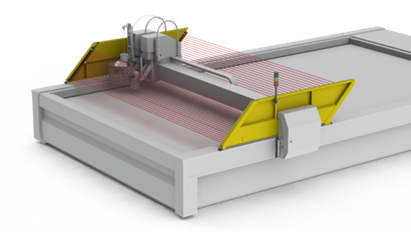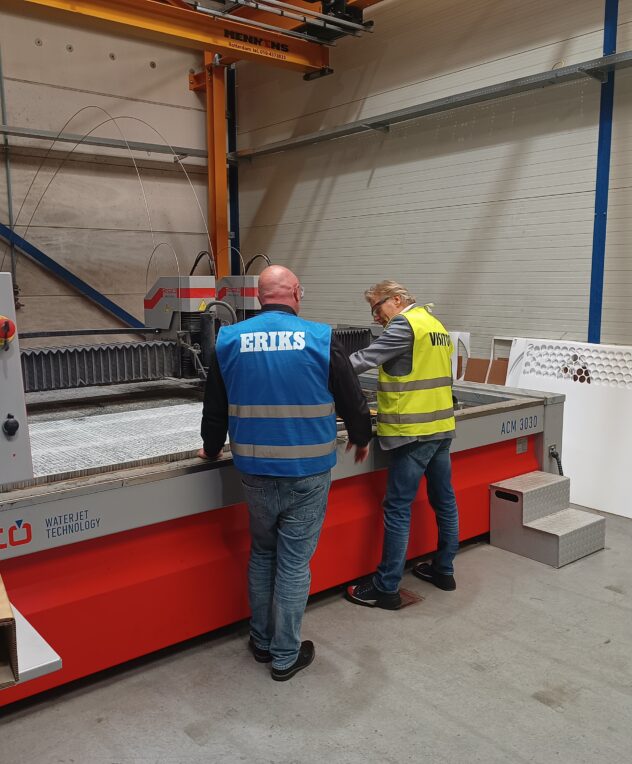
Reshoring Production in Europe
High Mix Low Volume 24/7 Production in European Manufacturing
In European industrial manufacturing, a trend has emerged – reshoring. This strategic change focusses on achieving operational efficiency and adaptability. At the heart of this lies the integration of automation into manufacturing, alongside a trend to design for automated production.
Original Equipment Manufacturers (OEM) are opting for smaller batch orders from local suppliers to optimize working capital. This enables them to use the flexibility inherent in local production, resulting in a trend towards high mix and low volume production – a true shift from offshore mass production solutions.
Meeting the demands of this transformed manufacturing demand in Europe requires machinery capable of low-manned and unmanned operation while accommodating a diverse product mix. Enter waterjet cutting technology, a powerful tool in the production engineer’s arsenal.
Waterjet cutting systems are adaptable, precise and capable of handling an extensive range of materials without the need for tool changes. This positions waterjet cutting technology as an ideal solution for unmanned or lightly manned high mix production scenarios. Waterjet cutting addresses the efficiency requirements inherent in high mix and low volume production, as required in the reshoring trend.
The incorporation waterjet cutting capabilities in house or close by allows manufacturers to streamline their supply chains further. With on-site waterjet technology, companies can inshore their supply chain for all materials, reducing the working capital in the parts pipeline and enhancing production agility.
In conclusion, the reshoring trend in European industrial manufacturing demands a production-centric approach, emphasizing precision, adaptability, and operational efficiency. Automation, particularly technologies like waterjet cutting is key to realizing the goals of high mix and low volume production. From an engineer’s perspective, waterjet cutting technology fits the demands of reshoring strategy in European manufacturing.
Reshaping European Manufacturing, reshoring industrial production and what this requires:
In European industrial manufacturing, a distinct trend is reshaping the industry – the strategic move towards reshoring. This shift isn’t just about relocating production closer to home; it’s a re-evaluation of operational strategy with a focus on efficiency and adaptability. At the heart of this evolution lies the integration of automation, particularly emphasizing design for automated production.
Original Equipment Manufacturers (OEM) are steering away from conventional mass production models, opting instead for smaller batch orders from local suppliers. The motivation is clear – optimizing working capital and leveraging the inherent flexibility of local production. The result is a move towards high mix and low volume production, disrupting current offshore mass production solutions.
This transformation in manufacturing in Europe requires cutting machinery capable of unmanned or lightly manned operation. This is precisely where the precision and versatility of waterjet cutting technology come into play as a powerful tool in the arsenal of production engineers.
Waterjet cutting , applied for cutting metals, cutting non ferro, cutting composites or cutting plastics stands out for its adaptability, precision, and capacity to handle an extensive range of materials without the need for tool changes. This makes waterjet cutting an ideal solution for the demands of high mix and low volume production scenarios in a low-manned operation or unmanned 24/7 operation which fits well with the reshoring trend. In the end a machine that can run overnight and in unmanned production is a very powerful tool. Cutting a mix of materials in one production run without tool changes to make the cutting of materials more complex increases reliability in production.
One of the remarkable aspects of waterjet cutting for industry is its that it will apply for a diverse array of materials, ranging from cutting metals, both ferrous and non-ferrous, to cutting composites, glass, plastics, and other precision parts. Being able to cut any material on demand in a mix of production batches, manufactured on demand direct from the production planning and with an unmanned 24/7 cutting system brings both power and precision to the production floor. Offering precision parts ready to use in assembly , machining or welding without needing to grind, clean up or finish the parts as there is no heat affected zone can help create a truly lean manufacturing system that is future proof in a dynamic production environment.
The incorporation of in-house waterjet cutting capabilities further enables manufacturers to take control of their supply chains, effectively shortening the industrial supply chain for all materials. This not only reduces dependence on external suppliers but also diminishes the working capital in the parts pipeline, contributing to heightened production agility.
Inshoring the supply chain through waterjet cutting isn’t merely about reshuffling logistics; it’s a strategic move towards precision-driven, adaptable production models. Waterjet cutting technology, with its capacity to cut through metals, non-ferrous materials, composites, glass, and plastics, empowers manufacturers to create precision parts without the constraints of traditional cutting methods.
In conclusion, as European industrial manufacturing takes back control of its manufacturing, waterjet cutting emerges as a powerful tool in the reshoring strategy. It’s not just about cutting materials; it’s about cutting a path towards a future where high mix and low volume production, inshored supply chains, and demand-driven manufacturing define the new norm. From the engineer’s perspective, waterjet cutting technology is at the forefront, shaping the future of European manufacturing with unparalleled precision and versatility.



